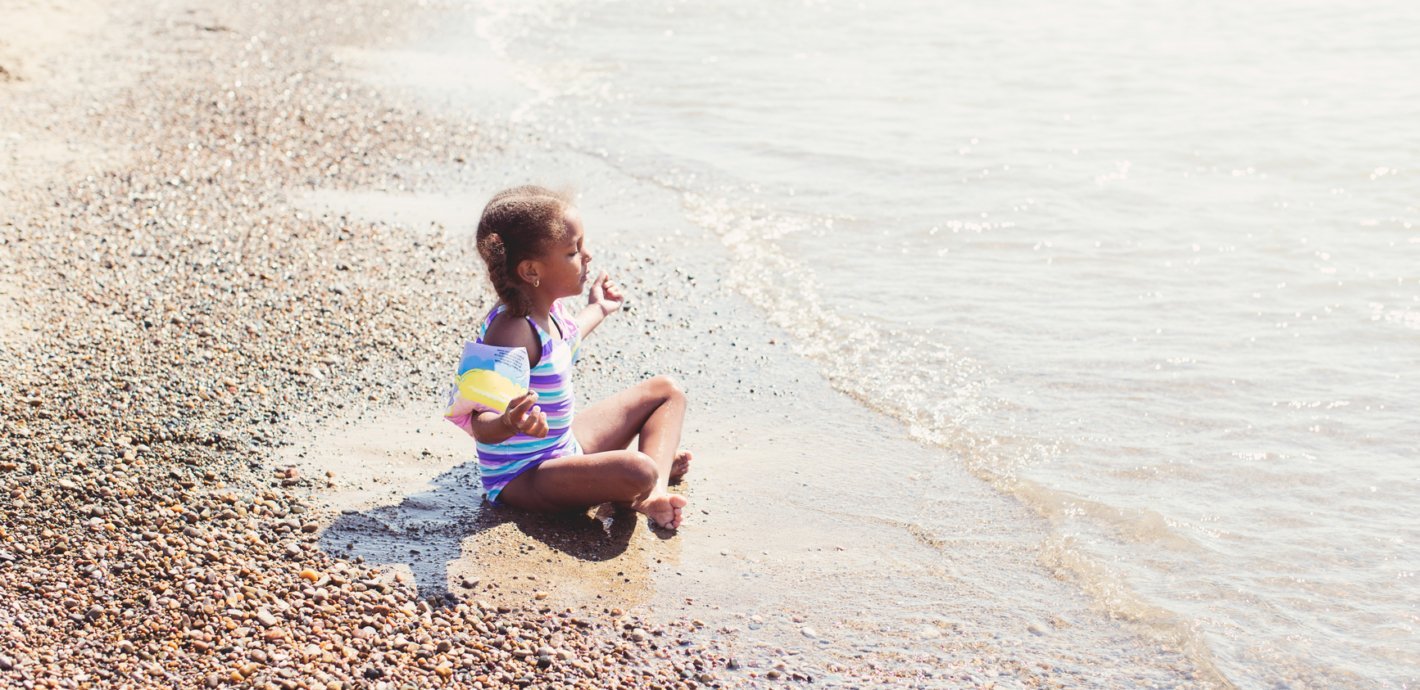Meditation is a lifelong practice. Not only do people tend to stick with it once they start reaping the mental and physical benefits, but it can also bring perspective, comfort, and healing throughout all the stages of life. Contrary to what you might think, childhood is no exception. By laying the foundation of mindfulness for your kids—or any child in your life—you’re providing them with an invaluable tool that will see them through life’s inevitable ups and downs.
Of course, different age groups will need different approaches that are in line with their maturity level. While there may be some variations in emotional aptitude, attention span, and willingness to participate within each of the three age groups outlined below, these are generally good starting points for developing interest in and enthusiasm for mindfulness and meditation.
Ages 6 and Under
For children in this age group, the habits they learn around interacting with the world are ones that they’ll hang onto forever, which is why if you can introduce mindfulness at a young age, you absolutely should.
There are quite a few ways to do this, and they all involve incorporating awareness and presence into everyday activities. Try giving your child the task of scanning an environment and remembering the arrangement of the objects in it. Maybe you focus on one wall or section of a room at a time, then have them close their eyes. With eyes closed, ask them to recollect it with specific questions about the colors of objects and where they’re located. You can do these types of exercises anywhere—in the park, at home, in the car—and adjust the difficulty based on their age.
Another option is to look at a picture together and ask your child how many different colors they see. You can help them by pointing out colors they’ve missed or counting the colors they’ve listed already. Giving your child these little moments of being 100 percent present helps them understand and relate to the world around them.
When you ask them to tell you how many different types of flowers they see at the park, for example, what you’re really asking them to do is be aware and interact with their environment. This may also serve as a natural way for them to gather knowledge. They may might become curious and ask you what the names of certain flowers are, what a specific type of tree is called, or why leaves are different colors in certain seasons. In this way, these exercises can be a natural learning tool.
I suggest keeping mindfulness exercises to five minutes or less for this age group. You want to keep them excited, and if you spend too much time quizzing them, they may start to get bored.
Ages 7 to 12
In this age group, you can gently introducing the concept of meditation. Again, the maximum amount of time you want to spend on this in one sitting is five minutes. Have your child sit down and close their eyes, drawing their attention to their breath.
Explain that awareness of your breath is very important because we are breathing all day and we don’t even think about it. We take roughly 12,800 breaths in 12 hours. How often are we aware of it? If they can just focus on their breath for two minutes, watching it go in and out, that’s a great start. To help them, you can ask where their breath is. Is it in their chest? In their stomach? In their low belly?
Once they’re comfortable with two minutes of focused breathing, follow that with up to three minutes of counting breaths. They can count the breath at their own pace, seeing how high their number count can get. Depending on their age, they can count up to 100 and then start over again until the three minutes are finished, or keep counting as high as they can for the full three minutes. This can actually turn the meditation into a sort of challenge or game, perhaps setting a new number goal each day or week, which provides a sense of accomplishment and may help them continue their interest in meditation over time.
Your child can also keep track of how many times their mind wanders during each session. They must know that it’s okay for that to happen, and that they just need to bring their mind back to the breath.
The benefits of this practice will come automatically. If you have a relaxed breath, you’ll instinctively have a relaxed body and mind. Consider this analogy to help explain it to the little one: Breath is the string that holds the beads of a necklace together. You can’t see the string, but it’s there supporting the beads. Similarly, you cannot see the breath, but our minds, bodies, and souls are all hanging on it. It’s the life force.
You can also encourage them to use either part of this exercise in moments when they feel stressed, nervous, or upset. Sitting down to take 10 deep breaths can work wonders for a child who is having an intense moment. This learned ability to connect with their breath and utilize the mind-body connection can also enhance your child’s performance in sports, studies, or any other activity.
RELATED: How Finding Meditation as a Child Shaped My Life
Ages 13 and Up
To get a teenager started with meditation, you’ll want to follow the same steps outlined above for ages 7 to 12. Once they’ve mastered basic breathing exercises, they can move on to meditation that more closely resembles what an adult would practice.
When they’re ready, guide them to bring their awareness into their third eye area. Normally, I suggest incorporating some sound, ideally the sound of “om.” What I recommend is that they bring in an image of “om” in their third eye area—whatever that may mean to them—and start to mentally repeat “om, om, om” for about three to five minutes. Then, instruct them to let go of both the image and the repetition, and allow themselves to go into a deeper place.
The idea here is to get lost in the moment—not thinking about anything, even their breath. If their mind wanders, just allow it to go. If thoughts are popping up, let them come and go; don’t fight it. This can be practiced for as many minutes as desired, and when they’re ready to stop, they should rub their palms to reactivate their senses, and then open their eyes and be back in the room.
It can be difficult to get teenagers interested in meditation (or anything else, for that matter), but in my experience, once they’ve started to get a taste of the benefits, they love it. The initial challenge is introducing them to it and then getting them to actually try it. If you can manage to get a teenager to practice meditation for 28 days—the amount of time it takes to form a habit—they’ll most likely get hooked and want to do it on their own.
It’s worth the effort because there are some unique benefits for adolescents, including improved focus on studies, which comes from better clarity of mind, a heightened ability to pay attention, and a more positive state of mind. These improvements can also help when dealing with the emotions that come along with being a teenager. They may be more gentle as well as less angry stressed, peer-pressured, and more in control of their mind and their feelings. Through inner transformation, outer behavior changes. Of course, this isn’t an overnight phenomenon, but you may start to notice changes gradually.
Lastly, introducing your child to meditation is a bonding experience, no matter their age. Anytime you engage in an an activity together, you get the opportunity to learn about each other on a deeper level. If the whole family is getting involved in meditation, it won’t feel like a burden, but rather an activity that brings you together and enhances your connection.









Comments (0)